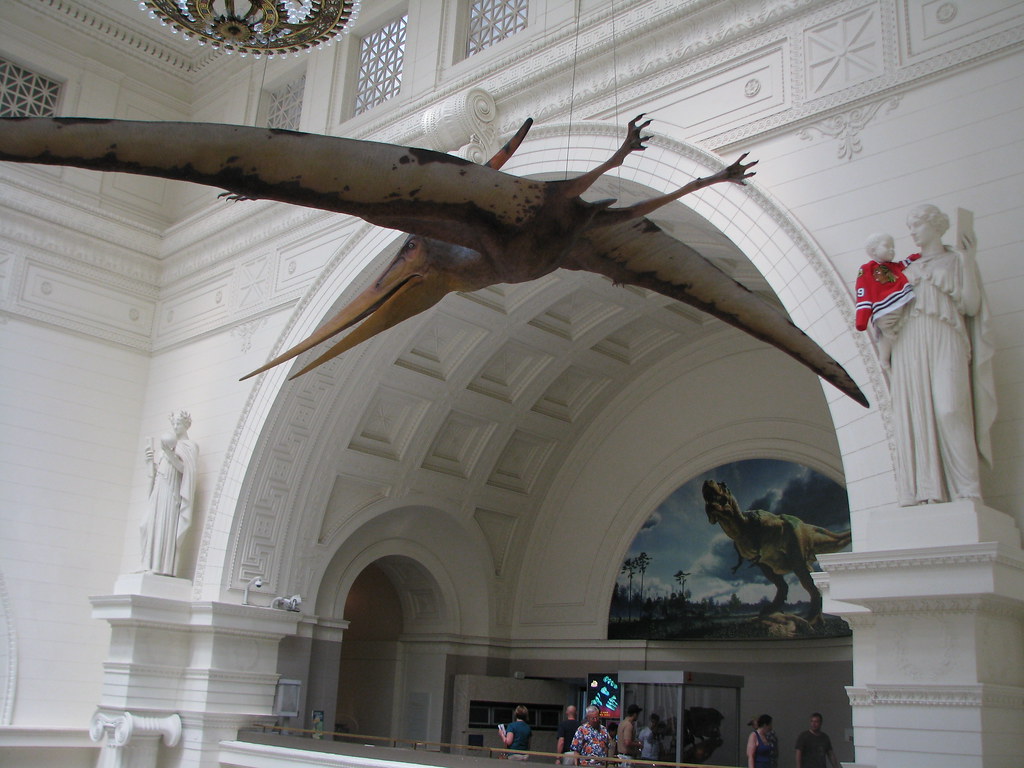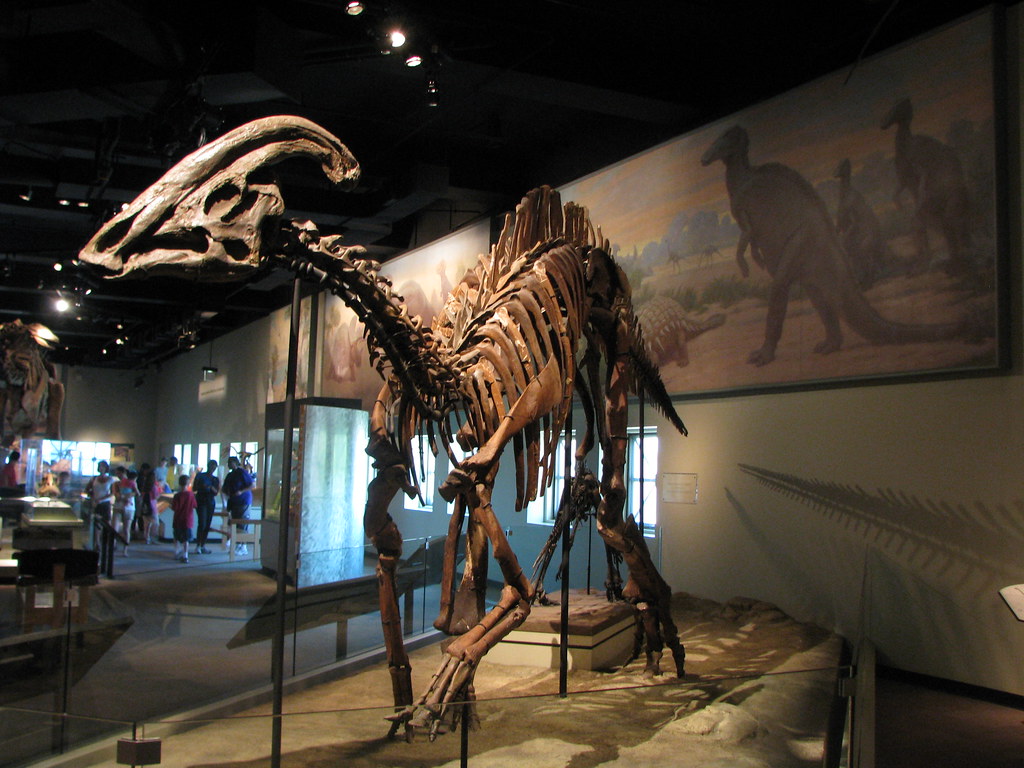A line of people snakes through the north entryway, populated mostly by locals taking advantage of a promotion offering free entry for state residents. From the middle of a group of twentysomethings, I hear a man's voice express mild disappointment as he peers past the ticket counters at the famous tyrant dinosaur beyond.
"I thought she'd be bigger."
"Just wait 'til you're below her," I respond.

After attending the Wild Things conference this weekend, conversing with all sorts of people about conservation and urban ecology in the Midwest US, I grabbed the chance to visit the Field Museum.
The Field is one of my favorite places to spend a day indoors. In a previous post, I did a walkthrough of the Field's dinosaur hall (with more photos here). I thought that this time, I might aim a more critical eye at the exhibit, especially concerning the role of paleoart. Due to the heavy weekend crowd, I didn't even try for exhaustive documentation, but I think I got enough to be worth sharing here, and I'll supplement with some of my older photos. I'd also recommend Ben Miller's thoughtful walkthrough and review of the entire Evolving Planet exhibit at Extinct Monsters.

The most visible pieces of 2-D paleoart in the Field are the Charles R. Knight murals, mounted high around the perimeter of the dinosaur hall as well as select positions along the exhibit's length. They surely deserve prominent display (the first paleoart visitors encounter would be Gurche's Sue mural overlooking the queen herself). I would love to see more contemporary artists given more prominence. Perhaps a revisit of classic Knight scenarios and compositions, with information given about the evolution of ideas in the last century of paleontological study.



Is that sacrilege? Maybe it is, but for the collection's importance to the history of paleoart, these pieces arguably work at cross-purposes to the content of the exhibit. In Evolving Planet, aside from "how do we know this?" passages on informational panels intended to counter creationist prejudices visitors may bring with them, the story of the science isn't foregrounded.* So it's a bit counterproductive to have so much antiquated scientific illustration present, without equally prominent discussion of how the science has progressed. In a museum where space is at a premium, it may be a pipe dream, but it's a pipe dream I like.
This is not to say that the art's vintage is entirely unremarked upon: for instance, Knight's place in the history of the science is called out in one of the informational panels, opposite the Stegosaurus mount.

The exhibit isn't entirely devoid of newer art. The didactic panels accompanying fossil mounts include serviceable, if sometimes shrink-wrappy, occasionally GSP-posed, illustrations of the animals.


There's no information on the artist. The style is sometimes too airbrushy, which doesn't do much for me personally.


Some of the panels also include cladistic diagrams, which are helpful to ground the animals in their evolutionary context. There's even an explanation of what a cladogram is, and tough words like "Marginocephalians." Contrast this with a panel earlier in the exhibit, in which the Ediacaran biota is referred to simply as the "earliest animals." Such concision is understandable. But the amount of fine-grain information provided in the dinosaur hall implicitly confirms a visitor's idea that these animals are of the utmost importance.


In the small pocket of the hall dedicated to the evolution of birds, casts of Archaeopteryx and Sinornis fossils are accompanied by fully feathered models, as well as illustrations of Deinonychus and Sinornithosaurus in the old-school, grudgingly feathered mode.




The theropods aren't the only 3-D work on display. The Parasaurolophus vocalization model is pretty great, and after visitors meet the iconic Herrerasaurus model upon entry to the dinosaur hall, they even get the chance to breeze by a big model of a plant.

"Evolving Planet" is a great exhibit, and one I recommend to anyone visiting Chicago. Attentive visitors will definitely walk out of it with new knowledge of and appreciation for evolutionary history. Though this post may seem a bit nit-picky, it was valuable for me to visit with the intention of doing more than ogling the mounts one more time. After all, the exhibit turns 11 this year. It's reached the age of the exhibit it replaced, "Life Through Time." So it's only natural that it is starting to show its age. I think it's a good time to imagine the next form a paleontological exhibit may take at the Field. My wishlist? More on bird evolution in the dinosaur hall. And throughout, more contemporary paleoart integrated with displayed fossil specimens, more on the stories of how discoveries have been made and how they've enriched our understanding of life's history.
But hey, you can't complain too much when Tiktaalik is at the party.

* To see an exhibit at the Field that explicitly brings the scientific process into its narrative (see their compact-but-wonderful Lichens exhibit).

Thanks for the shout out! The newer art is by Karen Carr, fyi.
ReplyDeleteI'm glad you addressed the elephant in the room re: the Knight murals. It seems like heresy, but as great as it is that these historically relevant works are on display, one has to wonder whether they are misleading the majority of visitors.
Thanks for the ID! She's really good, but her dinosaurs are not my favorites.
DeleteWhile the Knight art might be outdated, it certainly needs to be displayed somewhere rather than boxed up and put in storage. Perhaps if they drew more direct attention in the exhibit as to its outdated nature and had up to date stuff by it. That might be a more accurate way of presenting science anyway. More as a process.
ReplyDeleteCertainly. That would be my dream exhibit.
DeleteDid Gurche illustrate any dinosaur books or anything? Between his Sue and a piece he did for National Geographic in the 90s (a really cool poster insert that had allosaurs among a herd of sauropods) he's done two of my favorite pieces of paleoart. Goolging his name mostly shows his hominid work (which are also cool but I really like his dinosaurs).
ReplyDeleteJust curious, why is there a red sweater on the infaxt in the statue?
ReplyDeleteThat was one of the 2010 photos. It's the Chicago Blackhawks jersey, they must have been doing well at the time?
ReplyDelete